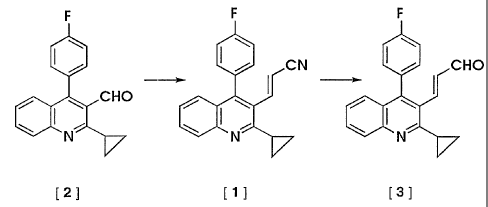Some of the information on this Web page has been provided by external sources. The Government of Canada is not responsible for the accuracy, reliability or currency of the information supplied by external sources. Users wishing to rely upon this information should consult directly with the source of the information. Content provided by external sources is not subject to official languages, privacy and accessibility requirements.
Any discrepancies in the text and image of the Claims and Abstract are due to differing posting times. Text of the Claims and Abstract are posted:
| (12) Patent: | (11) CA 2338334 |
|---|---|
| (54) English Title: | PROCESS FOR PRODUCING QUINOLINE DERIVATIVE AND INTERMEDIATE |
| (54) French Title: | PROCEDE DE PREPARATION D'UN DERIVE DE QUINOLEINE ET PRODUIT INTERMEDIAIRE POUR CE PROCEDE |
| Status: | Deemed expired |
| (51) International Patent Classification (IPC): |
|
|---|---|
| (72) Inventors : |
|
| (73) Owners : |
|
| (71) Applicants : |
|
| (74) Agent: | SMART & BIGGAR |
| (74) Associate agent: | |
| (45) Issued: | 2008-07-15 |
| (86) PCT Filing Date: | 1999-07-22 |
| (87) Open to Public Inspection: | 2000-02-03 |
| Examination requested: | 2003-11-25 |
| Availability of licence: | N/A |
| (25) Language of filing: | English |
| Patent Cooperation Treaty (PCT): | Yes |
|---|---|
| (86) PCT Filing Number: | PCT/JP1999/003923 |
| (87) International Publication Number: | WO2000/005213 |
| (85) National Entry: | 2001-01-22 |
| (30) Application Priority Data: | ||||||
|---|---|---|---|---|---|---|
|
The present invention relates a process for producing
the quinoline derivative (3) via the nitrile compound (1)
obtained by reacting the aldehyde compound represented by
formula (2) with diethyl cyanomethylphosphonate and its
intermediate (1).
L'invention concerne un procédé de préparation d'un dérivé (3) de quinoléine, ce procédé étant caractérisé en ce que sa préparation passe par un nitrile (1) qui peut être préparé par réaction d'un aldéhyde (2) avec un phosphonate diéthyl cyanométhyle. L'invention concerne également le produit (1) intermédiaire pour ce procédé.
Note: Claims are shown in the official language in which they were submitted.
Note: Descriptions are shown in the official language in which they were submitted.

For a clearer understanding of the status of the application/patent presented on this page, the site Disclaimer , as well as the definitions for Patent , Administrative Status , Maintenance Fee and Payment History should be consulted.
| Title | Date |
|---|---|
| Forecasted Issue Date | 2008-07-15 |
| (86) PCT Filing Date | 1999-07-22 |
| (87) PCT Publication Date | 2000-02-03 |
| (85) National Entry | 2001-01-22 |
| Examination Requested | 2003-11-25 |
| (45) Issued | 2008-07-15 |
| Deemed Expired | 2016-07-22 |
There is no abandonment history.
| Fee Type | Anniversary Year | Due Date | Amount Paid | Paid Date |
|---|---|---|---|---|
| Registration of a document - section 124 | $100.00 | 2001-01-22 | ||
| Application Fee | $300.00 | 2001-01-22 | ||
| Maintenance Fee - Application - New Act | 2 | 2001-07-23 | $100.00 | 2001-06-22 |
| Maintenance Fee - Application - New Act | 3 | 2002-07-22 | $100.00 | 2002-06-25 |
| Maintenance Fee - Application - New Act | 4 | 2003-07-22 | $100.00 | 2003-06-23 |
| Request for Examination | $400.00 | 2003-11-25 | ||
| Maintenance Fee - Application - New Act | 5 | 2004-07-22 | $200.00 | 2004-06-25 |
| Maintenance Fee - Application - New Act | 6 | 2005-07-22 | $200.00 | 2005-06-22 |
| Maintenance Fee - Application - New Act | 7 | 2006-07-24 | $200.00 | 2006-06-22 |
| Maintenance Fee - Application - New Act | 8 | 2007-07-23 | $200.00 | 2007-06-26 |
| Final Fee | $300.00 | 2008-04-24 | ||
| Maintenance Fee - Patent - New Act | 9 | 2008-07-22 | $200.00 | 2008-06-25 |
| Maintenance Fee - Patent - New Act | 10 | 2009-07-22 | $250.00 | 2009-06-19 |
| Maintenance Fee - Patent - New Act | 11 | 2010-07-22 | $250.00 | 2010-06-17 |
| Maintenance Fee - Patent - New Act | 12 | 2011-07-22 | $250.00 | 2011-06-08 |
| Maintenance Fee - Patent - New Act | 13 | 2012-07-23 | $250.00 | 2012-06-14 |
| Maintenance Fee - Patent - New Act | 14 | 2013-07-22 | $250.00 | 2013-06-12 |
| Maintenance Fee - Patent - New Act | 15 | 2014-07-22 | $450.00 | 2014-07-09 |
Note: Records showing the ownership history in alphabetical order.
| Current Owners on Record |
|---|
| NISSAN CHEMICAL INDUSTRIES, LTD. |
| Past Owners on Record |
|---|
| OHARA, YOSHIO |
| SUZUKI, MIKIO |
| TAKADA, YASUTAKA |
| YANAGAWA, YOSHINOBU |